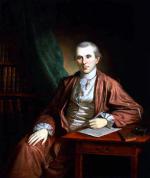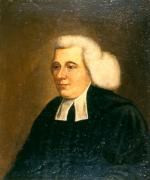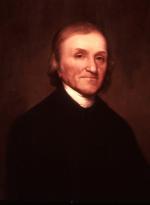![header=[Marker Text] body=[Dr. Benjamin Rush envisioned a new type of education in post-Revolutionary America, a useful education in the liberal arts. Rush, with the assistance of Col. John Montgomery of Carlisle, founded Dickinson College to prepare an engaged citizenry able to meet the needs of the new nation. Chartered on September 8, 1783 and named for John Dickinson, the college was the first established west of the Susquehanna River.] sign](kora/files/1/10/1-A-36E-139-ExplorePAHistory-a0m0m9-a_450.gif)
Mouse over for marker text
Name:
Dickinson College [Education]
Region:
Hershey/Gettysburg/Dutch Country Region
County:
Cumberland
Marker Location:
W. High St. at campus in Carlisle
Dedication Date:
July 1, 1947
Behind the Marker
Few Revolutionary-era leaders possessed the intellectual vigor or public resourcefulness of  Benjamin Rush, who stands with
Benjamin Rush, who stands with Benjamin Franklin as a model public citizen in Pennsylvania history. Like Franklin, Rush had a deep curiosity about science, medicine, public affairs, and the role of education in nurturing an enlightened citizenry able to preserve the legacy of rights and liberty. Also like Franklin, Rush's religious views evolved toward a more egalitarian and nonsectarian viewpoint. Rush was instrumental in the establishment of Dickinson College, the first college chartered in the United States after independence from England. Dickinson also claims to be the first church-related (Presbyterian) degree-granting institution in Pennsylvania.
Benjamin Franklin as a model public citizen in Pennsylvania history. Like Franklin, Rush had a deep curiosity about science, medicine, public affairs, and the role of education in nurturing an enlightened citizenry able to preserve the legacy of rights and liberty. Also like Franklin, Rush's religious views evolved toward a more egalitarian and nonsectarian viewpoint. Rush was instrumental in the establishment of Dickinson College, the first college chartered in the United States after independence from England. Dickinson also claims to be the first church-related (Presbyterian) degree-granting institution in Pennsylvania.
Anticipating the needs of the new nation, in his influential "Plan for the Establishment of Public Schools" Benjamin Rush called for the creation of a university in Philadelphia and four colleges distributed throughout the Commonwealth: one in Philadelphia, another in Lancaster, a third in Carlisle, and a fourth in Pittsburgh. Rush went further, however, calling for the creation of a public academy in each county supported by state funds. This latter recommendation predated by a half-century the establishment of state-supported common schools.
"Plan for the Establishment of Public Schools" Benjamin Rush called for the creation of a university in Philadelphia and four colleges distributed throughout the Commonwealth: one in Philadelphia, another in Lancaster, a third in Carlisle, and a fourth in Pittsburgh. Rush went further, however, calling for the creation of a public academy in each county supported by state funds. This latter recommendation predated by a half-century the establishment of state-supported common schools.
Chartered less than a week after the Treaty of Paris ended hostilities with England, Carlisle's Dickinson College was a cornerstone of Rush's scheme for enlightened citizenship in the Commonwealth. In placing the school in Carlisle, which is situated between the Susquehanna River and the Allegheny Mountains, Rush anticipated the continuous movement of population across the Cumberland Valley into the Pennsylvania heartland. The college grew out of an older grammar school established a decade earlier, and from the start it embodied Rush's faith in liberty and learning as agents of political stability and social progress.
Named for Pennsylvania's Governor John Dickinson a school benefactor and signer of the U.S. Constitution, the actual charter is a testament to Rush's personal powers of persuasion and his talents in overcoming both political and religious opposition. Trustees of the church-affiliated College of New Jersey (later Princeton University) were among those who doubted the necessity of a college in remote Carlisle. True to Rush's conviction, and the charter of other Presbyterian colleges, the founding document prohibited discrimination against other Christian denominations in admission or faculty appointments. Employees were required to pledge an oath of loyalty to the Commonwealth of Pennsylvania.
John Dickinson a school benefactor and signer of the U.S. Constitution, the actual charter is a testament to Rush's personal powers of persuasion and his talents in overcoming both political and religious opposition. Trustees of the church-affiliated College of New Jersey (later Princeton University) were among those who doubted the necessity of a college in remote Carlisle. True to Rush's conviction, and the charter of other Presbyterian colleges, the founding document prohibited discrimination against other Christian denominations in admission or faculty appointments. Employees were required to pledge an oath of loyalty to the Commonwealth of Pennsylvania.
In 1803, the original college building burned to the ground during a violent snowstorm. Rush, John Montgomery, a Congressman and trustee, and college president Charles Nisbet secured the assistance of famed architect Benjamin Latrobe to design a new building. Thanks to private donations from the likes of Thomas Jefferson, "Old West," as the structure was called, opened two years later. The Scottish-born Nisbet overcame initial resistance from trustees, including Dickinson, and attracted an outstanding faculty that included James Ross, Joseph Priestley, and Thomas Cooper. Later additions to the faculty, instructors like Spencer Fullerton Baird and Charles Francis Himes, bolstered the school's reputation in the sciences.
With Rush's support, Nisbet championed a curriculum that was useful and civic-minded. True to the spirit of the American Enlightenment, Dickinson offered a curriculum strong in the classics and in the natural sciences. Knowledge was to be applied to the conditions of political and economic life, and to improving the Republic. Such beliefs inspired a tradition of civic engagement that is still evident today.
Students were able to supplement daily tutorials with visits to the nearby Cumberland County courthouse, where trustees saw the virtue of studying democracy up close. Long forays into the surrounding countryside provided the chance for observing natural processes. Field studies and applied learning became early and distinctive features of the college curriculum and at mid-century trustees added a program in legal studies, what became the Dickinson Law School. (The college and the law school have had separate charters since 1890.)
Like many select private liberal-arts colleges removed from large centers of population, Dickinson struggled financially in the early years. (In 1833, Dickinson joined struggling Allegheny College in switching affiliation to the Methodist Episcopal Church.) Economic uncertainties and internal factionalism forced the trustees to suspend operations twice before the Civil War. The college survived the maelstrom of the war, and the Confederate invasion of the Cumberland Valley that ended with the battle at Gettysburg in July 1863. President James Buchanan and Chief Justice Roger Taney were two of the notable graduates from this era who had a deciding influence on national affairs.
Distinguished alumni include a half dozen United States Congressmen, corporate executives Alfred V. du Pont and John Curley, and entertainers Stuart Pankin and Rosie O'Donnell. In 2006, Dickinson decided to stop publicizing its place in the U.S. News and World Report ranking of "America's Best Colleges." The following year, College President William G. Durden joined other college presidents in asking schools not to participate in the "reputation" part of the survey.
Anticipating the needs of the new nation, in his influential
Chartered less than a week after the Treaty of Paris ended hostilities with England, Carlisle's Dickinson College was a cornerstone of Rush's scheme for enlightened citizenship in the Commonwealth. In placing the school in Carlisle, which is situated between the Susquehanna River and the Allegheny Mountains, Rush anticipated the continuous movement of population across the Cumberland Valley into the Pennsylvania heartland. The college grew out of an older grammar school established a decade earlier, and from the start it embodied Rush's faith in liberty and learning as agents of political stability and social progress.
Named for Pennsylvania's Governor
In 1803, the original college building burned to the ground during a violent snowstorm. Rush, John Montgomery, a Congressman and trustee, and college president Charles Nisbet secured the assistance of famed architect Benjamin Latrobe to design a new building. Thanks to private donations from the likes of Thomas Jefferson, "Old West," as the structure was called, opened two years later. The Scottish-born Nisbet overcame initial resistance from trustees, including Dickinson, and attracted an outstanding faculty that included James Ross, Joseph Priestley, and Thomas Cooper. Later additions to the faculty, instructors like Spencer Fullerton Baird and Charles Francis Himes, bolstered the school's reputation in the sciences.
With Rush's support, Nisbet championed a curriculum that was useful and civic-minded. True to the spirit of the American Enlightenment, Dickinson offered a curriculum strong in the classics and in the natural sciences. Knowledge was to be applied to the conditions of political and economic life, and to improving the Republic. Such beliefs inspired a tradition of civic engagement that is still evident today.
Students were able to supplement daily tutorials with visits to the nearby Cumberland County courthouse, where trustees saw the virtue of studying democracy up close. Long forays into the surrounding countryside provided the chance for observing natural processes. Field studies and applied learning became early and distinctive features of the college curriculum and at mid-century trustees added a program in legal studies, what became the Dickinson Law School. (The college and the law school have had separate charters since 1890.)
Like many select private liberal-arts colleges removed from large centers of population, Dickinson struggled financially in the early years. (In 1833, Dickinson joined struggling Allegheny College in switching affiliation to the Methodist Episcopal Church.) Economic uncertainties and internal factionalism forced the trustees to suspend operations twice before the Civil War. The college survived the maelstrom of the war, and the Confederate invasion of the Cumberland Valley that ended with the battle at Gettysburg in July 1863. President James Buchanan and Chief Justice Roger Taney were two of the notable graduates from this era who had a deciding influence on national affairs.
Distinguished alumni include a half dozen United States Congressmen, corporate executives Alfred V. du Pont and John Curley, and entertainers Stuart Pankin and Rosie O'Donnell. In 2006, Dickinson decided to stop publicizing its place in the U.S. News and World Report ranking of "America's Best Colleges." The following year, College President William G. Durden joined other college presidents in asking schools not to participate in the "reputation" part of the survey.










